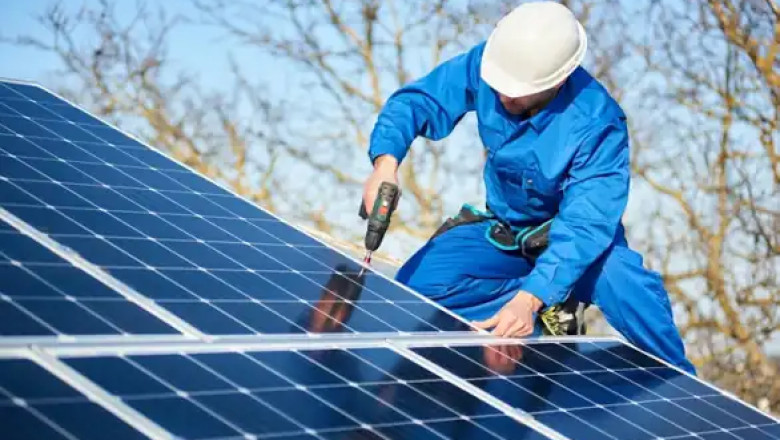views
Living near the coast has its perks—beautiful views, fresh air, and consistent sun exposure. That makes it an ideal environment for solar energy systems. But coastal homes also face challenges that can shorten the lifespan of solar equipment and increase the need for solar repairs.
From high humidity to salty air and seasonal storms, these environmental factors can have a significant impact on solar panel efficiency and system longevity. Understanding how your local climate affects your solar setup can help you minimize maintenance issues and extend the system’s life.
1. The Problem with Salt Air
Salt in the air isn’t just a threat to vehicles and metal furniture—it can also corrode your solar panel’s components. Electrical connectors, mounts, and metal frames are particularly vulnerable to corrosion caused by salt deposits. Over time, this can compromise performance or lead to system failures.
Corrosion is typically a slow process, which is why regular inspection and cleaning are critical. It’s not always visible from the ground, and left unchecked, it can become a costly repair.
2. Moisture and Humidity Exposure
Coastal climates like Myrtle Beach deal with persistently high humidity levels. Moisture in the air can find its way into electrical boxes or cracks in the panels themselves. This might result in short circuits, delamination, or accelerated degradation of internal materials.
For example, sealants that keep panels watertight can break down faster in damp climates, creating entry points for moisture. Once inside, the risk of electrical failure increases. Annual inspections should include a check of seals, wiring enclosures, and junction boxes to ensure everything is watertight.
3. Wind and Storm Damage
Coastal areas are prone to sudden wind gusts, tropical storms, and hurricanes. These can do significant physical damage to solar panels and their mounting structures. Panels may get cracked, lifted, or displaced entirely.
Storms can also cause airborne debris to strike your solar equipment. While panels are built to withstand moderate hail and wind, extreme conditions can cause mounting hardware to loosen or frames to warp.
To mitigate this, homeowners should ensure their solar panels are installed with hurricane-rated mounts and that their system undergoes post-storm inspections when needed.
4. Seasonal Debris and Panel Fouling
Besides mechanical damage, panels located near trees or in salt-laden air may accumulate debris, grime, and mineral buildup more rapidly. This fouling reduces the panel’s ability to absorb sunlight and can lead to overheating, which may damage the cells over time.
Cleaning panels periodically is essential—but in coastal environments, it’s often not enough to rely on rain alone. Depending on the exposure level, you may need professional cleanings every 6 months to maintain optimal performance.
5. Shorter Component Lifespan
Even if the panels themselves remain in decent condition, coastal climates can wear out inverters, connectors, and other support components faster than in inland areas. Temperature fluctuations, high UV exposure, and moisture all contribute to component aging.
If your system seems to be underperforming or inconsistent, it might be a sign that one of these elements needs repair or replacement. Performance monitoring tools can help identify where the issue lies before it escalates into a full system failure.
6. Designing for Coastal Resilience
Many of these issues can be minimized with proper system design and material choice. Coastal solar setups should use:
-
Corrosion-resistant mounts (e.g., aluminum or stainless steel)
-
Weather-sealed connectors and junction boxes
-
UV- and salt-resistant cable insulation
-
Elevated mounting systems that promote airflow and reduce heat buildup
Working with experienced professionals who understand regional conditions is crucial. Coastal systems aren’t one-size-fits-all, and adapting to local climate realities will reduce the need for frequent repairs.
7. When to Call for Professional Repairs
Even the most resilient solar system will eventually need some degree of repair. The key is knowing when professional help is required.
You should contact a solar technician if:
-
Your power output drops noticeably without a clear cause
-
You see visible damage or corrosion
-
You receive error messages from your inverter
-
You’ve recently experienced a major weather event
-
Your system hasn’t been inspected in over a year
Prompt attention to these signs can prevent further damage and avoid higher repair costs down the line.
Protecting Your Solar Investment
Routine maintenance and an awareness of local environmental stressors can go a long way toward preserving your solar system’s performance. In areas like Myrtle Beach, where salt and storms are a constant factor, homeowners benefit from working with local experts who understand how to build and maintain coastal solar systems properly.
If you live near the coast, proactive care will help you avoid frequent issues and ensure that your solar panels continue to provide clean, efficient energy for decades. Partnering with experienced providers like myrtle beach solar can also help ensure that your system is built for the climate and maintained with your region's unique conditions in mind.














Comments
0 comment